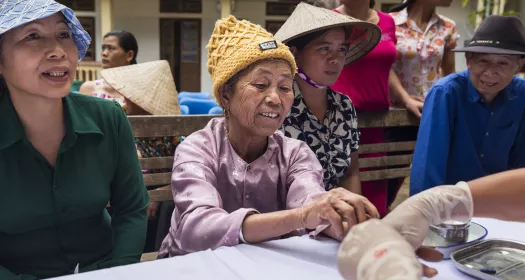Media Library
icon
-
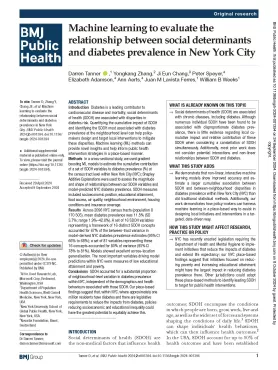 PDFlockPopulation Health / PublicationMachine learning to evaluate the relationship between social determinants and diabetes prevalence in New York CityDiabetes is a leading contributor to cardiovascular disease and mortality; social determinants of health (SDOH) are associated with disparities in diabetes risk. Quantifying the cumulative impact of SDOH and identifying the SDOH most associated with diabetes prevalence at the neighborhood level can help policy-makers design and target local interventions to mitigate these disparities. Machine learning (ML) methods can provide novel insights and help inform public health intervention strategies in a place-based manner. In a cross-sectional study, we used gradient boosting ML models to estimate the cumulative contribution of a set of SDOH variables to diabetes prevalence (%) at the census tract level within New York City (NYC); Shapley Additive Explanations were used to assess the magnitude and shape of relationships between our SDOH variables and model-predicted NYC diabetes prevalence. SDOH measures included socioeconomic position, educational attainment, food access, air quality, neighbourhood environment, housing conditions and insurance coverage.
PDFlockPopulation Health / PublicationMachine learning to evaluate the relationship between social determinants and diabetes prevalence in New York CityDiabetes is a leading contributor to cardiovascular disease and mortality; social determinants of health (SDOH) are associated with disparities in diabetes risk. Quantifying the cumulative impact of SDOH and identifying the SDOH most associated with diabetes prevalence at the neighborhood level can help policy-makers design and target local interventions to mitigate these disparities. Machine learning (ML) methods can provide novel insights and help inform public health intervention strategies in a place-based manner. In a cross-sectional study, we used gradient boosting ML models to estimate the cumulative contribution of a set of SDOH variables to diabetes prevalence (%) at the census tract level within New York City (NYC); Shapley Additive Explanations were used to assess the magnitude and shape of relationships between our SDOH variables and model-predicted NYC diabetes prevalence. SDOH measures included socioeconomic position, educational attainment, food access, air quality, neighbourhood environment, housing conditions and insurance coverage. -
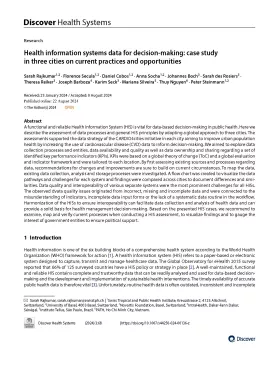 PDFlockPopulation Health / PublicationHealth information systems data for decision‑making: case study in three cities on current practices and opportunitiesA functional and reliable Health Information System (HIS) is vital for data-based decision-making in public health. The paper describes the assessment of data processes and general HIS principles by adapting a global approach to three cities. The assessments supported the data strategy of the CARDIO4Cities initiative in each city aiming to improve urban population health by increasing the use of cardiovascular disease (CVD) data to inform decision-making.
PDFlockPopulation Health / PublicationHealth information systems data for decision‑making: case study in three cities on current practices and opportunitiesA functional and reliable Health Information System (HIS) is vital for data-based decision-making in public health. The paper describes the assessment of data processes and general HIS principles by adapting a global approach to three cities. The assessments supported the data strategy of the CARDIO4Cities initiative in each city aiming to improve urban population health by increasing the use of cardiovascular disease (CVD) data to inform decision-making. -
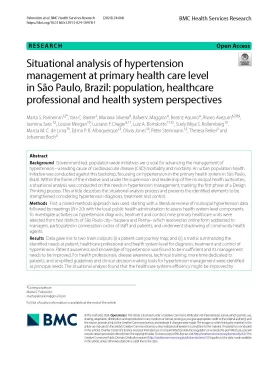 PDFlockPopulation Health / PublicationSituational analysis of hypertension management at primary health care level in São Paulo, Brazil: population, healthcare professional and health system perspectivesGovernment-led, population-wide initiatives are crucial for advancing the management of hypertension − a leading cause of cardiovascular disease (CVD) morbidity and mortality. An urban population health initiative was conducted against this backdrop, focussing on hypertension in the primary health system in São Paulo, Brazil. Within the frame of the initiative and under the supervision and leadership of the municipal health authorities, a situational analysis was conducted on the needs in hypertension management, marking the first phase of a Design Thinking process. This article describes the situational analysis process and presents the identified elements to be strengthened considering hypertension diagnosis, treatment and control.
PDFlockPopulation Health / PublicationSituational analysis of hypertension management at primary health care level in São Paulo, Brazil: population, healthcare professional and health system perspectivesGovernment-led, population-wide initiatives are crucial for advancing the management of hypertension − a leading cause of cardiovascular disease (CVD) morbidity and mortality. An urban population health initiative was conducted against this backdrop, focussing on hypertension in the primary health system in São Paulo, Brazil. Within the frame of the initiative and under the supervision and leadership of the municipal health authorities, a situational analysis was conducted on the needs in hypertension management, marking the first phase of a Design Thinking process. This article describes the situational analysis process and presents the identified elements to be strengthened considering hypertension diagnosis, treatment and control. -
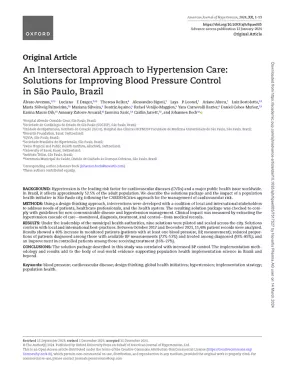 PDFlockPopulation Health / PublicationAn Intersectoral Approach to Hypertension Care: Solutions for Improving Blood Pressure Control in São Paulo, BrazilHypertension is the leading risk factor for cardiovascular diseases (CVDs) and a major public health issue worldwide. In Brazil, it affects approximately 52.5% of the adult population. We describe the solutions package and the impact of a population health initiative in São Paulo city, following the CARDIO4Cities approach for the management of cardiovascular risk.
PDFlockPopulation Health / PublicationAn Intersectoral Approach to Hypertension Care: Solutions for Improving Blood Pressure Control in São Paulo, BrazilHypertension is the leading risk factor for cardiovascular diseases (CVDs) and a major public health issue worldwide. In Brazil, it affects approximately 52.5% of the adult population. We describe the solutions package and the impact of a population health initiative in São Paulo city, following the CARDIO4Cities approach for the management of cardiovascular risk. -
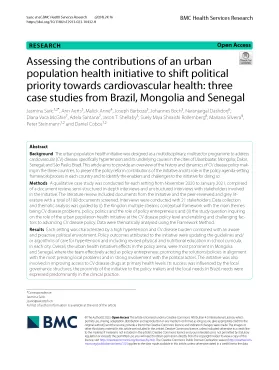 PDFlockPopulation Health / PublicationAssessing the contributions of an urban population health initiative to shift political priority towards cardiovascular healthAssessing the contributions of an urban population health initiative to shift political priority towards cardiovascular health: three case studies from Brazil, Mongolia and Senegal
PDFlockPopulation Health / PublicationAssessing the contributions of an urban population health initiative to shift political priority towards cardiovascular healthAssessing the contributions of an urban population health initiative to shift political priority towards cardiovascular health: three case studies from Brazil, Mongolia and Senegal -
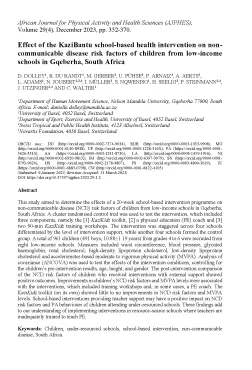 PDFlockPopulation Health / PublicationEffect of the KaziBantu school-based health intervention on NCDsEffect of the KaziBantu school-based health intervention on NCDs
PDFlockPopulation Health / PublicationEffect of the KaziBantu school-based health intervention on NCDsEffect of the KaziBantu school-based health intervention on NCDs -
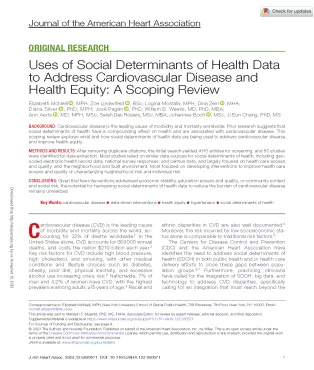 PDFlockPopulation Health / PublicationUses of social determinants of health data to address CVD and Health EquityUses of social determinants of health data to address CVD and Health Equity
PDFlockPopulation Health / PublicationUses of social determinants of health data to address CVD and Health EquityUses of social determinants of health data to address CVD and Health Equity -
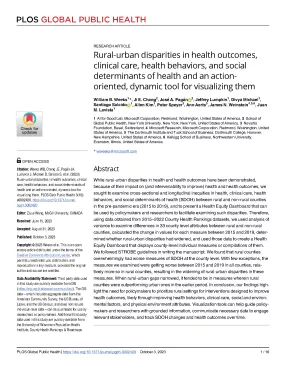 PDFlockPopulation Health / PublicationVisualizing rural urban disparities in health outcomesVisualizing rural urban disparities in health outcomes
PDFlockPopulation Health / PublicationVisualizing rural urban disparities in health outcomesVisualizing rural urban disparities in health outcomes -
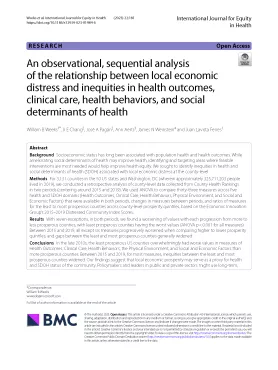 PDFlockPopulation Health / PublicationEconomic distress and health equityEconomic distress and health equity
PDFlockPopulation Health / PublicationEconomic distress and health equityEconomic distress and health equity -
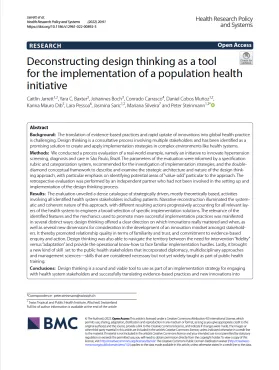 PDFlockHealth System Strengthening / PublicationDeconstructing design thinking as a tool for the implementation of a population health initiativeDesign thinking is a sound and viable tool to use as part of an implementation strategy for engaging with health system stakeholders and successfully translating evidence-based practices and new innovations into routine practice, thereby addressing an important knowledge—practice gap and, more broadly, contributing to the strategic repertoire available to implementation science.
PDFlockHealth System Strengthening / PublicationDeconstructing design thinking as a tool for the implementation of a population health initiativeDesign thinking is a sound and viable tool to use as part of an implementation strategy for engaging with health system stakeholders and successfully translating evidence-based practices and new innovations into routine practice, thereby addressing an important knowledge—practice gap and, more broadly, contributing to the strategic repertoire available to implementation science. -
 PDFlockPopulation Health / PublicationAdvancing artificial intelligence in health maturityArtificial Intelligence in health care offers a way to transform health systems from being reactive to being proactive, predictive, and even preventive. The Novartis Foundation and PATH launched the tool in six countries in 2021 and 2022: Argentina, Brazil, Chile, Philippines, Uruguay, and Vietnam. This white paper shares an overview of the experience these countries had in conducting the self-assessment.
PDFlockPopulation Health / PublicationAdvancing artificial intelligence in health maturityArtificial Intelligence in health care offers a way to transform health systems from being reactive to being proactive, predictive, and even preventive. The Novartis Foundation and PATH launched the tool in six countries in 2021 and 2022: Argentina, Brazil, Chile, Philippines, Uruguay, and Vietnam. This white paper shares an overview of the experience these countries had in conducting the self-assessment. -
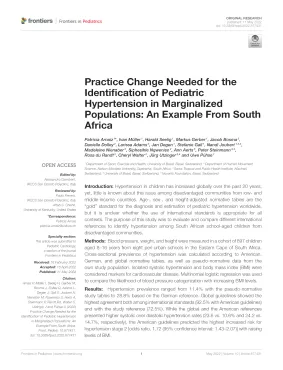 PDFlockHypertension / PublicationPractice Change Needed for the Identification of Pediatric Hypertension in Marginalized Populations: An Example From South Africa
PDFlockHypertension / PublicationPractice Change Needed for the Identification of Pediatric Hypertension in Marginalized Populations: An Example From South Africa


